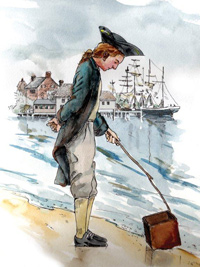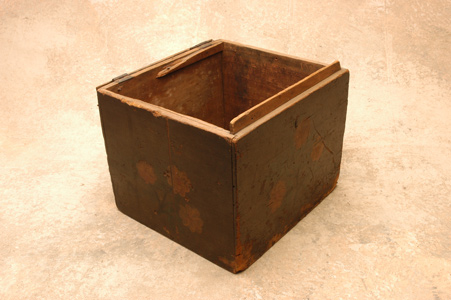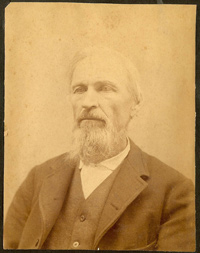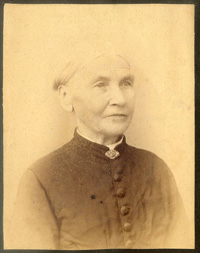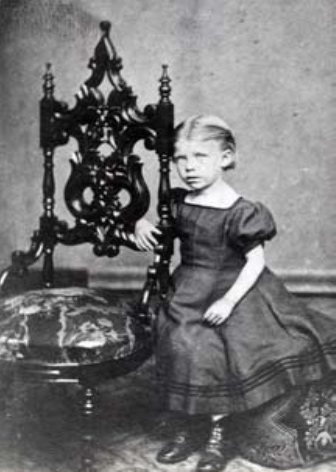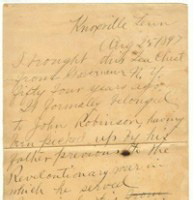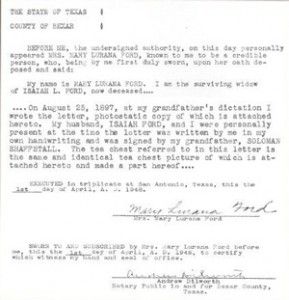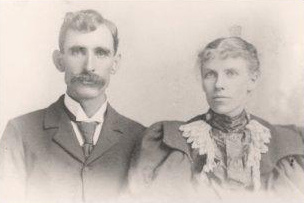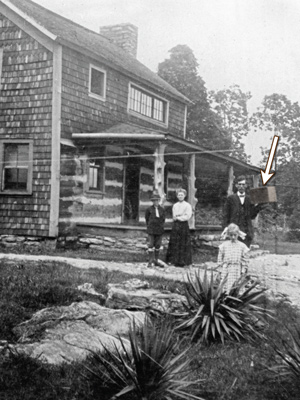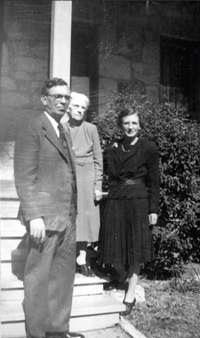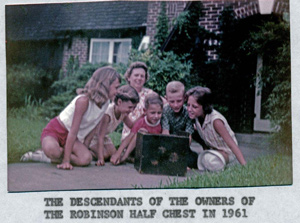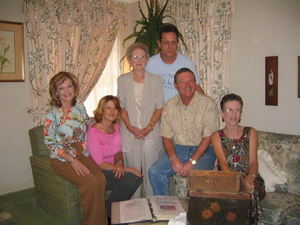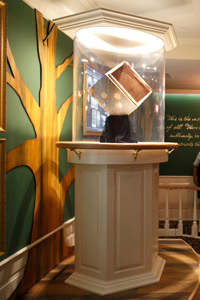A Box Worth Keeping
A Family’s Relic of the Founding Generation
In the early morning of December 17, 1773, 15-year old John Robinson walked the shoreline near Dorchester Heights, just outside of Boston. It was the morning after over 90,000 pounds of East India Company tea had been dumped into Boston Harbor. As the water, thick with tea leaves, gently lapped ashore, Robinson’s eye caught sight of a wood chest partially buried in the sand. It was a simple chest, dark green and small in size – 10” high, 13 1/16’ wide, 11 7/8” deep – made of ½” thick wood.
His heart must have raced when he saw it, for John Robinson would have known what all of Boston knew – just hours earlier, in the dark of night, a band of men loosely disguised as Indians struck an act of defiance against British authority. Well aware of the consequences, but motivated perhaps by youthful daring, John picked up the partially buried chest and took it home.
Two hundred thirty-nine years later, young John’s find, one of only two known surviving tea chests from the Boston Tea Party, and known now as the Robinson Half Chest, is on display in the Boston Tea Party Ships & Museum in Boston.
That this simple crate – a tangible embodiment of an important act of defiance of ordinary people in the face of tyranny – survived relatively intact for over two centuries is a testament to the power of oral history and the pride of family heritage.
Who was this family who tenaciously hung on to what would appear to the casual observer to be just a salvaged wood crate?
From Hand to Hand – 1773 to 2004
This raw piece of American history exists today only because several generations of one family believed in the threads of the special story that surrounded the unremarkable-looking wooden box they had in their possession. Generation after generation they held on to their family treasure. They passed it down, and along with it the unusual story of its finding and its connection to an important event in America’s founding. Family lore told them it was special, but not just how special, as only recently did family oral history become documented history.
John Robinson: 1773 – 1819 (46 years)
The chest remained with John Robinson from the day he picked it up in 1773, throughout his marriage to his wife, Nancy, and until his death, believed to be around 1819.
“Grandma Holden”: 1819 – 1843 (24 years)
When Nancy Robinson remarried not long after John’s death, she held on to the chest until 1843 – 70 years after John found it on beach off Dorchester! At that time, Grandma Holden, as she was now called by the family, was living in Gouverneur, New York.
She parted with the storied chest in 1843, giving it to Solomon Shaffstall as a gesture of gratitude for the help he gave to her son, John Robinson, Jr. and his wife, Patience Marsh, when both were severely ill.
Solomon Shaffstall: 1843-1872 (29 years)
Although living in Door County, Wisconsin at the time, Shaffstall was no stranger to the Robinsons. He was family, related to them through his marriage to Zilpha Lurana Marsh, the sister of Patience Marsh Robinson, wife of John Robinson, Jr. Solomon had an abiding interest in history and had often discussed the chest and its remarkable link to America’s founding with Grandma Holden.
Mary Lurana Cade Ford: 1872-1949 (77 years)
Twenty-nine years after bringing the chest home, Solomon gave it to his 8 year-old granddaughter, Mary Lurana Cade, who had lived with Solomon and Zilpha Lurana since the death of their daughter and son-in-law shortly after Mary Lurana’s birth in 1864.
Mary Lurana clearly recalled receiving the chest from her grandfather as a container for her dolls. She remembered it had colonial “poke bonnets” in it which she loved to wear when playing dress-up. For a time she kept the chest on a low closed shelf, only to discover that her favorite cat had claimed it as a cozy, protected place to have her kittens.
In the documentation of the chest’s provenance, there is a notarized affidavit written and signed in 1948 by 84-year-old Mary Lurana supporting the authenticity of an attached letter. That letter, dictated to her and signed by her grandfather, Solomon Shaffstall on August 25, 1897, recorded his gift of the chest from Robinson’s widow, Grandma Holden, 54 years earlier.
As is the American way, the family moved from time to time in in search of opportunity, and during those journeys, the chest was always carefully brought with them. It was with Mary Lurana in Knoxville, Tennessee, where she married Isaiah L. Ford in 1896.
While in Knoxville, the Ford family, which had grown to include a son, William Cade, born in 1897, and daughter, Helen, born in 1898, resided for a time in the General James White House, itself a piece of early American history. In 1910, the Fords and the chest moved to Corpus Christi, Texas, then on to San Antonio, Texas.
Helen married George Lucas Waring, also of San Antonio. Following Isaiah Ford’s death in 1917, Mary Lurana moved in with Helen and George. The treasured chest moved with her. Mother and daughter, both educators, had much in common, including the ownership of a school which they founded in 1923. As recalled by Helen, during their long years together mother and daughter shared a fascination with the chest, speaking often about the history of their family treasure. They speculated; they wondered.
Helen Ford Waring and William Cade Ford: 1949-1976 (27 years)
When Mary Lurana died in 1949, the chest was passed on to both her children: Helen, still living in San Antonio, and William, living in Laredo, Texas. The chest remained with Helen.
Although the chest was technically in Helen’s sole possession for only 12 years, remarkably, due to the closeness and shared interests of Helen and Mary Lurana, the family treasure, so valued by both, remained in seamless possession of the two women for a total of 89 years – from 1872, the time it was given to 8 year-old Mary Lurana, until Helen’s passing in 1961.
Helen’s contribution to the authentication of the chest is invaluable. She had an inquisitive mind, and had always been curious about the family story of the chest’s role in the Boston Tea Party. As a teacher, she knew that in order to validate the family lore about the tea chest’s origin, she would need facts supported by documentation.
Thus began her 10 year quest to weave together the facts that would link the family’s history with the unbroken chain of possession of the treasured wooden chest. With William’s help, she began her research, compiling documents, stories and photos which traced the chest back to John Robinson. Through their remarkable efforts, oral history became documented history.
Upon Helen’s death, the chest was given to William, who, along with Helen, had inherited the chest from their mother, Mary Luarana Cade Ford. While in William’s possession, an unexpected call came from the Smithsonian Institute. With that call, the family treasure was on its way to attaining long-deserved recognition.
The Robinson Half Chest Goes to the Smithsonian
In preparation for a multi-year celebration leading to America’s Bicentennial in 1976, the renowned institution had heard of the existence somewhere in Texas of a tea chest salvaged from the Boston Tea Party. They tracked it down. They asked for permission to display the chest in one of their museum exhibitions during the 1976 Bicentennial celebrations. The family agreed. The Robinson Half Chest, as it was officially designated, was on its way to Washington D.C.
Once there, the family treasure was curated into the National Portrait Gallery’s First Bicentennial Exhibit, “In the Minds and Hearts of the People – Prologue to the American Revolution 1760-1774,” assuming its place as a relic of the founding generation. The exhibition opened on June 14, 1974, and the Robinson Half Chest was viewed by millions.
At the conclusion of the exhibit, the Robinson Half Chest was returned to William’s daughter, Betty Ford Goodman, who had inherited it from her father who had passed away while it was on exhibit. Following its moment in the national spotlight, the chest sat in a bank vault in Laredo for years until Betty’s husband, Andre Goodman, Sr. decided to bring it back home to the family where it was placed, still crated, underneath a table.
Betty Ford Goodman: 1976 – 2004 (28 years)
Betty Ford Goodman and her husband, along with their five young children, were now caretakers of “the box,” as they called it.
The Goodman children, adults now, have fond memories of ”the box.” Adrienne Goodman Trevino recalls whenever any of the five had a research paper due at school, they would think of “the box,” pull it out, and take it, along with the documentation so carefully researched by great-aunt Helen, to class to display along with their paper. As teenagers, they remember it was the subject of curiosity among their friends. When they brought it out to show, they did so with pride – family pride.
While the stature of “the box” was elevated by Helen’s diligent documentation, to the Goodmans, it was a sentimental family heirloom surrounded by mystique. It was so intertwined with their family history that they viewed it more as a piece of their heritage rather than as a tangible symbol of an important moment in America’s history.
However, each time Betty saw it, she had the same lingering thought: ‘the box’ should be in a place where the public could see it and appreciate its significance. But where? To even begin the process seemed daunting.
The Chest Comes Full Circle – 2004 to Present
The answer came in 2004. Andre Goodman, Jr., Betty’s son, discovered that Historic Tours of America was planning to build a new museum in Boston to commemorate the Boston Tea Party. Andre picked up the phone and called Chris Belland, the company’s CEO. He recounted the story of the special chest that had been in the family for generations, tracing it back to its discovery by John Robinson. Would Belland be interested in it for the new museum?
Just as Helen had been, Belland was curious. If the chest could pass the necessary authentication tests and if its documentation could be verified to establish its provenance, would the Goodman’s have any interest in selling it? The Goodmans were, and the authentication process began. Finally, Betty’s wish was granted – “the box” was finally on its way to a special place where it would be fully appreciated.
Today, 239 years later, it is the centerpiece of the new Boston Tea Party Ships & Museum in Boston.
The Boston Tea Party Ships & Museum Grand Opening June 26, 2012
It was quite a moment for three of Betty Goodman’s children – Jenel Goodman, Shelly Goodman Henson, and Andre Goodman, Jr., accompanied by his wife, Nancy – as they walked into the Boston Tea Party Ships & Museum for the first time during the Grand Opening on June 26, 2012. What they saw took their breath away. There, right before them, for all the world to see, was “the box!”
They stood proudly at the rail, watching their family treasure glow softly in warm lighting as it slowly turned inside a tall column of clear, protective glass. On the wall behind the chest, beautifully framed and displayed, was its provenance, the documentation of its history – their family’s history.
For the museum visitors standing with them, the chest was a fragile American relic, tangible proof of America’s quest for freedom. For the Goodman’s it was that, and more. For them, it represented the pride of family heritage and an abiding belief in a story kept alive from one generation to the next through the power of oral history. “The box,” a piece of American history so remarkably and carefully passed from hand to hand through generations of one family, had come full circle.
It was indeed a box worth keeping.
